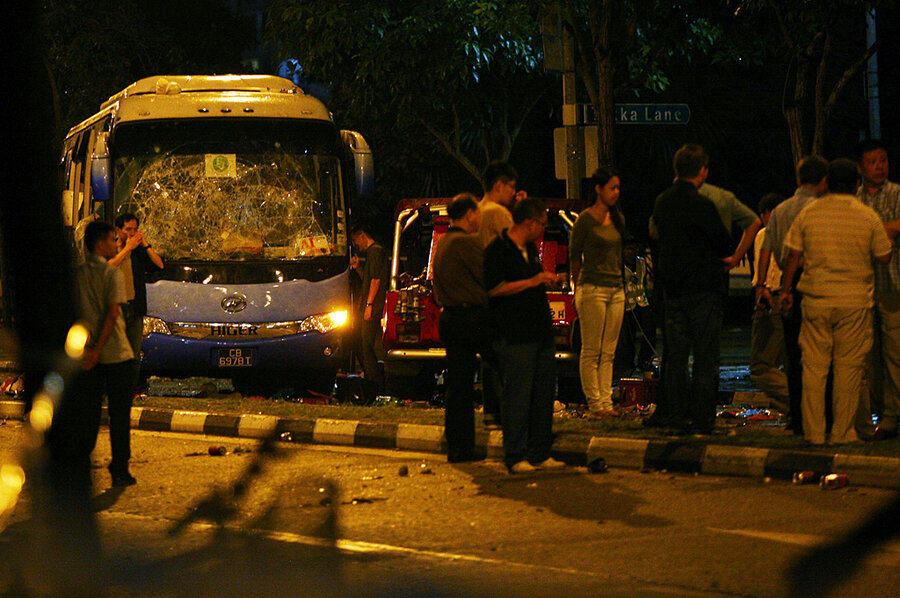Singapore riots put spotlight on tensions with migrant workers
Loading...
- A roundup of daily news reports.
Hundreds of migrant workers rioted in Singapore’s ethnic Indian district Sunday, torching vehicles and hurling rocks at advancing police forces. While the unrest was swiftly subdued, it shocked this orderly city-state and sparked concern that ethnic and class tensions may be coming to a head amid widening income inequality.
The clash was sparked by the death of a 33-year-old Indian guest worker, who was hit by a city bus driven by a Singaporean, Bloomberg reported. Shortly afterward, a swelling crowd went on a rampage in the Little India neighborhood, a popular destination for South Asian workers on Sundays to eat, drink, and socialize.
The Wall Street Journal reported from the scene late last night:
A crowd of about 400 foreign workers, angered by a fatal road accident, set fire to vehicles and attacked police and emergency services workers late Sunday in Singapore's ethnic Indian district, injuring at least 18 people in a rare riot in the city-state.
…Dozens of police officers, wearing Kevlar helmets and carrying riot shields, [were] cordoning off the area late Sunday. At least two police cars were turned on their sides, and smoke rose from burned-out vehicles along the road where the riot took place.
The Wall Street Journal reports that riot police were able to contain the violence within two hours, and without firing any shots, according to a subsequent police press briefing.
Its modest size notwithstanding, the riot carried heavy implications for Singapore’s social cohesion, throwing in sharp relief the simmering tensions between ethnic Singaporeans and many thousands of migrant workers who form the backbone of the economy. Singapore’s economic boom over the past two decades swelled the ranks of low-paid, transient wage earners, whose numbers soared from 10 percent of the total workforce in 1990 to about 25 percent today, The Associated Press reports.
For some of Singapore’s long-time residents, the violence carried distant echoes of a racially charged riot that shook Singapore for seven days almost 45 years ago, in 1969, when clashes between the ethnic Chinese majority and Malay minority left at least four people dead and 80 injured.
The current riot was “a new thing, that’s definitely a watershed of a kind,” Bilveer Singh, an associate professor at National University of Singapore’s department of political science, told Bloomberg. “At a broad, strategic level, it is something new after a long time.”
The government’s reaction is likely to be stern, Mr. Singh predicted: “Singaporeans won’t tolerate this because Singaporeans are becoming very nationalistic.”
Singapore's Prime Minister Lee Hsien Loong said on Monday that authorities will “spare no effort to identify the culprits and deal with them with the full force of the law," according to Al Jazeera. As of Monday, 27 people were detained for their role in the violence, 24 of them Indian citizens.
It remains to be seen if the potential clampdown quells or further fuels the discontent.
Roy Ngerng, a blogger focused on social issues, said that last night’s clash might be just the first eruption of festering unease, unless the living and working conditions of transient workers improve, according to The Associated Press:
"The inequality that has taken root in Singapore has dire consequences and they are beginning to show. … Perhaps, it is to be expected that when we pay such (a) pittance … to people who have helped build our country – our buildings and roads – and yet expect them to toil in the most tiresome conditions."







